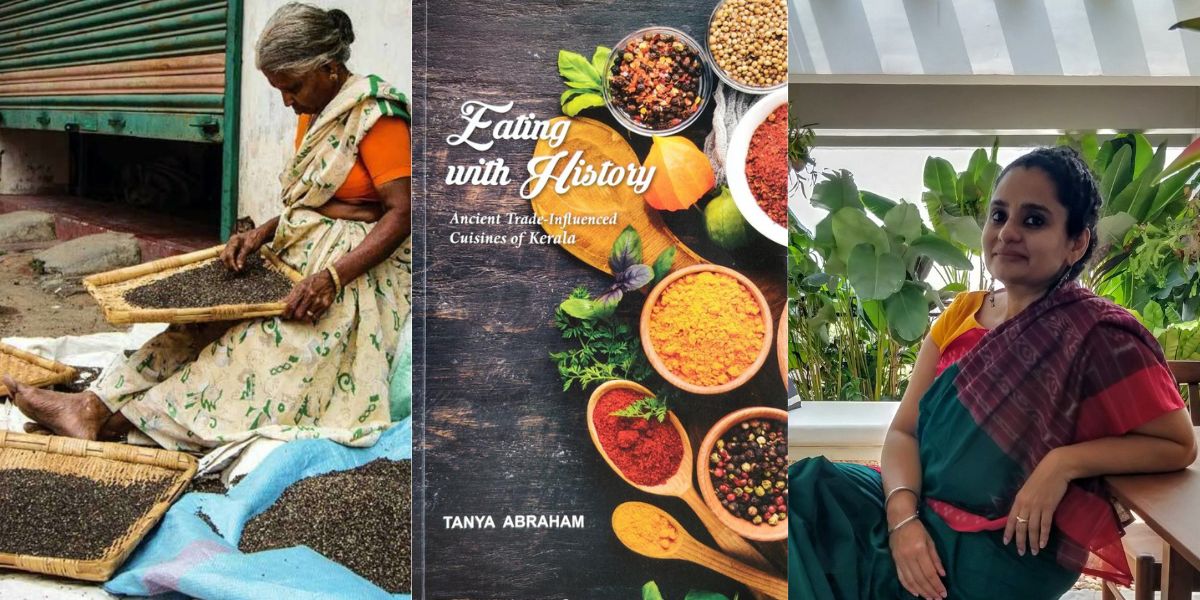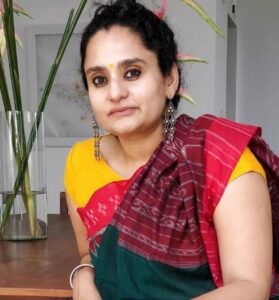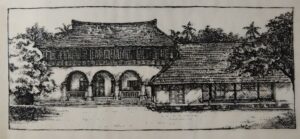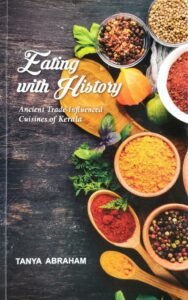Tanya Abraham’s ‘Eating with History’ is an ode to timeless recipes of amammas

Examining the historical backgrounds in which diverse communities and their patterns of consumption emerged in Kerala, Abraham's book offers fresh perspectives on comprehending Kerala's food culture. (Supplied)
In the hallowed kitchens of Kerala, whispers of centuries-old recipes echo through the corridors of time. It is here where Tanya Abraham, a connoisseur of history and a journalist by trade, dons the avatar of a culinary chronicler in her latest offering, ‘Eating with History.’
“Every project that I undertake bears an inextricable connection to my roots,” she reflects. Her formative years, she says, were marked by the communal exchange of food among diverse communities that flourished in Kerala due to the spice trade. This gave birth to diverse recipes and had a profound influence on her extensive writings on the subject.
Abraham was born and raised amid the ancient splendours of Fort Kochi. The crucible of cultures where Jews, Arabs, Muslims, and Konkani Brahmins coexisted became the backdrop against which Tanya’s passion for food and history burgeoned.
Examining the historical backgrounds in which diverse communities and their patterns of consumption emerged in Kerala, Abraham’s book offers fresh perspectives on comprehending Kerala’s food culture.

Tanya Abraham’s book pays tribute to the ingenuity and efforts of numerous women in Kerala’s kitchens. (Supplied)
The book pays tribute to the ingenuity and efforts of numerous women in Kerala’s kitchens. These are women who uphold and treasure recipes handed down through generations.
“It’s not just a collection of recipes, it’s a homage to the women who transformed their kitchens into sanctuaries of alchemy, where spices, herbs, and love melded into culinary magic,” Abraham shares.
“My childhood was woven with threads of food and history. The matriarchs of my home, particularly my indomitable grandmother, Annie Burleigh Kurishingal, were the unsung heroines shaping this narrative. ‘Eating with History’ is almost like reliving my grandmother’s mind in many ways,” she recalls.
The genesis of ‘Eating with History’ can be traced to Tanya’s earlier endeavour, ‘Fort Cochin,’ penned in 2009.
A decade later, she returned with a culinary magnum opus dedicated to her grandmother, Annie Burleigh Kurishingal.

Kurishingal ancestral home in Fort Kochi. Drawing by artist Priti Vadakkath, a member of the Kurishingal family. (Supplied)
This second offering is a tapestry of over 100 recipes meticulously curated from the kitchens of Kerala’s diverse communities.
“In my three years of study, it was understood that these communities, influenced by foreign trade in Kerala, drew their uniqueness from the marrying of flavours through cultures. It is assumed that in an otherwise predominantly vegetarian region, a variety of meats, fish and other seafood rose to become dominant foods at a later stage, curried to life from outside influences. The food trail is extensive, and I believe I may have only skimmed the surface of the food trove of these communities,” she elaborates.
At the centre of ‘Eating with History’ is Annie Burleigh, her grandmother, who was not only a culinary expert, but also a freedom fighter. She was the founder of the Mahila Samajam in Kerala and a municipal councillor (of the governing body in Fort Cochin).
Tanya’s narratives unfold like chapters in a historical novel. There are anecdotes of her grandmother’s starch-white chatta and mundu turning yellow after being imbued with the aromas of masalas. This, after laborious hours in the traditional kusinchya, a Portuguese derivative of the word for kitchen.

The genesis of ‘Eating with History’ can be traced to Tanya’s earlier endeavour, ‘Fort Cochin,’ penned in 2009. (Supplied)
“In my grandmother’s kitchen, the culinary symphony unfolded with a medley of flavours, from sandwiches and pies to corned beef and smoked ham. Pork, meticulously salted, and fresh fruits preserved in sugar syrup were staples. The menu seamlessly transitioned from suckling pig and leg of ham to the comforting embrace of more traditional Latin Catholic curries,” she reminisces.
“Halwa, cakes, and wines, each crafted with care, emerged incessantly, their aromatic presence wrapped in decorative paper before being sent cycling to neighbouring homes,” she tells South First.
These were the same homes that reciprocated the joy during Jewish festivals or Bakr-id.
“Fort Cochin’s enchanting blend of cultures found expression in our kitchen, where recipes spanning generations were skillfully prepared by the adept hands of the ladies in our household, a testament to the rich tapestry of our shared heritage,” adds Abraham.
When Abraham delved deeper into research, she uncovered the hidden threads that connect communities through an enchanting dance of flavours and traditions.
“The revelation of the Mappila sweet, Muttamalla, once a guarded secret of Arab descendants, finding an unexpected companion in the culinary repertoire of Paradesi Jews, serves as a poignant testament to the interlaced richness of Kerala’s diverse communities,” she notes.
For example, she states that of the many food ingredients introduced by the Portuguese, it is vinegar, which was a prime influencer of Kerala cuisine. Also, they brought yeast into the country and provided locals with leavened bread, previously unknown in Kerala.
The Portuguese are also given credit for the invention of puttu, a steamed rice cake, today one of the most popular Kerala staples.
Similarly, Tanya has noted that the consumption of bread and cakes like the brudher in Fort Cochin is an old tradition. The name hails from the Dutch word, brodjee, meaning bread.
The journey of crafting the book was, in many ways, a magical odyssey for Abraham.
“Finding authentic and undiluted recipes called for finding the right families and those willing to share them. I had to make sure I was representing facts right, and that I was doing right by them,” she adds.
Yet, ‘Eating with History’ is not confined to the gustatory senses alone.
It’s an exploration of identity, heritage, and the profound yet complex connection between food and culture.
Abraham’s endeavours also extend beyond the culinary realm, as evidenced by her commitment to Fort Kochi through art curation, establishment of art residencies, and community engagement.
“I am the curator of Kashi Art Gallery in Fort Kochi and the founder of the Kashi Art Residency to promote art education, and The Art Outreach Society (TAOS). It is a non-profit in Kochi that works with prisoners and underprivileged children using art as a tool,” she shares.
In a world that charges forward at a relentless pace, ‘Eating with History’ stands as a monument to the significance of preserving our culinary heritage.
Served with love are the Latin Catholic recipes by Annie Burleigh Kurishingal (Tanya’s grandmother) that await to be tried and tasted in every kitchen.
Ingredients:
Shrimp, cleaned and deveined: ¾ kg
Shallots: 10
Chilli powder: ½ tsp
Green chillies: 2, slit
Oil: 1 tablespoon
Salt: to taste
Water: for sprinkling
Instructions:
Heat oil in a pan.
Sauté the shallots in the heated oil until they turn color.
Add chilli powder and green chillies to the sautéed shallots.
Incorporate the cleaned and deveined shrimp into the pan.
Season with salt according to taste.
Sprinkle a little water over the ingredients.
Cook the mixture until the shrimp is tender.
A very popular snack among Cochinni Jews, the contents of the pastel can be varied. Pastel or pasthel in Cochin is different from elsewhere because of the locally available ingredients. Late Sara Cohen shared this recipe before she passed away in August 2019, leaving just two more Paradesi Jews in Kochi and India.
Ingredients:
Tuna: 1 tin (or its equivalent of fresh tuna)
Onion: 1 large, diced
Tomatoes: 1 large, diced
Green chillies: 2, diced
Coriander leaves: one small bunch, chopped
Rice flour: 1 cup
Flour: ¼ cup
Eggs: 2
Oil: 1 tbsp
Salt: to taste
For the filling:
Drain oil from the tuna tin and heat in a saucepan.
Add the onions and chillies and fry until light brown.
Now, add tomatoes and sauté until cooked.
Then, add the tuna and salt, and mix well.
Finally, add the coriander leaves last and mix well.
For the dough:
Sieve the rice flour and flour into a vessel.
Add the eggs and enough water to make a thin, clear batter.
Add salt and oil, mix well.
Heat a saucepan and pour a small amount of the batter into it. Swirl and pour out the excess to form a thin coating.
Cook until the edges start peeling off from the pan.
Remove from the pan and fill with the tuna filling, keeping the edges free.
Fold the edges on both sides and roll up until the filling is completely enclosed.
Heat oil in a vessel and fry until brown.

Jul 26, 2024

Jul 26, 2024

Jul 25, 2024

Jul 25, 2024

Jul 25, 2024

Jul 24, 2024